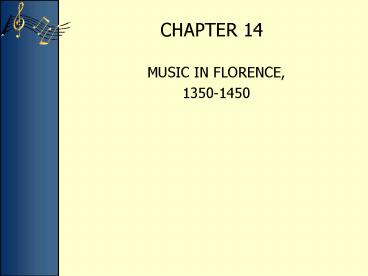MUSIC IN FLORENCE, - PowerPoint PPT Presentation
1 / 10
Title:
MUSIC IN FLORENCE,
Description:
... of the Middle Ages as a 'dark' age is a great exaggeration, the period ... for the arts and humanities generally in poetry, painting, sculpture, and music. ... – PowerPoint PPT presentation
Number of Views:67
Avg rating:3.0/5.0
Title: MUSIC IN FLORENCE,
1
CHAPTER 14
- MUSIC IN FLORENCE,
- 1350-1450
2
THE EARLY RENAISSANCE
- Renaissance means rebirth in the sense of a
reawaking. Although the description of the
Middle Ages as a dark age is a great
exaggeration, the period of the early Renaissance
(1350-1450) did see a reawakening of interest in
the art of classical antiquity and a quickening
of concern for the arts and humanities
generallyin poetry, painting, sculpture, and
music.
3
FLORENCE
- Florence might fairly be called the home of the
Italian Renaissance, possessing, as it does,
more great art per square foot than any city in
the world. Giotto, Donatello, Masaccio,
Brunelleschi, Botticelli, Leonardo da Vinci and
Michelangelo all graced Florence with their art
at various times between 1320 and 1490. Florence
was a city-state which by 1348 had a population
of about 100,000.
4
TRECENTO MUSIC AND THE SQUARCIALUPI CODEX
- The period of the 1300s in Italy is called the
trecento. By far the largest collection of
trecento music is the Squarcialupi Codex, name
after a Florentine organist who once owned the
manuscript. Compiled in Florence about 1415, the
Squarcialupi Codex contains 354 compositions and
constitutes a retrospective anthology of all of
forms of trecento music.
5
ITALIAN FIXED FORMS
- While the French had their fixed forms for
secular vocal music in the fourteenth century
(ballade, rondeau, and virelai), so too did the
Italians, specifically the madrigal, caccia, and
ballata. The trecento madrigal possessed AAB
form. The madrigal Non al suo amante of Jacopo
da Bologna (c1310-c1386) is typical of the
madrigal around 1350 in that it is highly florid,
but somewhat rigid rhythmically. The poem here,
by the early Renaissance humanist Frescesco
Petrarch (1304-1374), is exceptionally beautiful
and, typical of Renaissance poetry, is full of
classical allusions.
The beginning of Jacopo da Bolognas two-voice
madrigal Non al suo amante.
6
CACCIA AND BALLATA
- In Italian, caccia means hunt. A caccia is a
composition involving a musical canon in the
upper two voices supported by a slower moving
tenor. In a caccia one of the upper voices
chases after the other, and the Italian texts of
many caccias are about a hunt, either real or
amatory (of the beloved). - The ballata was a dance song with a choral
refrain. Its music and poetic form is similar to
the French virelai A (ripresa) b (piede) b
(piede) a (volta) A (ripresa). The terms piede
(foot), volta (turn), and ripresa (refrain)
recall the origins of the ballata as a monophonic
dance.
7
FRANCESCO LANDINI
- Francesco Landini (c1325-1397) was the most
important composer of the trecento. Landini was
a blind organist who worked at the church of San
Lorenzo (St. Lawrence) in the center of Florence.
Surviving from his pen are 140 ballatas, thirteen
madrigals, but only one caccia.
8
- Landinis ballata Or su, gentili spirti was said
to have been sung in 1389 in a garden party by
two women accompanied by a gentleman on the
lowest part. Landinis music is characterized by
flexible rhythms, florid melody, abundant thirds
and sixths, and an idiosyncratic cadence, called
the Landini cadence in which the cantus voice
drops from the seventh degree to the sixth before
jumping to the 8th and final degree.
9
The beginning of Landinis ballata Or su, gentili
spirti revealing languid rhythms and a florid
melody
10
The end of Landinis ballata Or su, gentili
spirti showing a Landini cadence































